Temperature-Controlled Laser Cutting of an Electrical Steel Sheet Using a Novel Fuzzy Logic Controller
Abstract
:1. Introduction
2. Experiment Procedure
Experimental Setup
3. Closed-Loop Control System
3.1. System Identification
3.2. PID-Type FLC Structure with an Online Fuzzy Tuner
3.3. Optimization Technique
4. Results and Discussion
4.1. Optimization Technique
4.2. Temperature Variation in Open Loop Control and PID-Type FLC with Online Fuzzy Tuner
4.3. Roundness Variation in Open-Loop Control and PID-Type FLC with Online Fuzzy Tuner
4.4. HAZ Variation in Open-Loop Control and PID-Type FLC with Online Fuzzy Tuner
5. Conclusions
- (1)
- A hybrid PSO-GWO algorithm was employed to find the optimal parameters of α, β, T1, T2, T3, T4, and T5 in the PID-type FLC with an online fuzzy tuner, and proved its effectiveness in the given laser cutting processes.
- (2)
- Through in the situ tuning of the control parameters, the PID-type FLC with an online fuzzy tuner outperformed the open-loop control in terms of performance and tracking responses.
- (3)
- A relation between the roundness of the cutting quality and the cutting speed was found. The roundness generally increased with the cutting speed, given a laser pulse frequency of 20 kHz or 40 kHz.
- (4)
- The PID-type FLC with an online fuzzy tuner stably maintained the controlled temperature at the cutting front of the workpiece, such that the roundness was significantly reduced and much smaller than that in the open-loop control cases.
- (5)
- The HAZ width exhibited a notable reduction during the process of pulsed laser cutting for non-oriented electrical steel sheets using the PID-type FLC with an online fuzzy tuner, as compared to the open-loop control. In comparison to a previous study using fuzzy gain scheduling for temperature control, the HAZ width produced by the PID-type FLC with an online fuzzy tuner was also much smaller.
- (6)
- The developed PID-type FLC with an online fuzzy tuner could reduce the cutting time while also achieving a smaller roundness and HAZ on the non-oriented electrical steel sheet.
Author Contributions
Funding
Institutional Review Board Statement
Informed Consent Statement
Data Availability Statement
Conflicts of Interest
References
- Oda, Y.; Kohno, M.; Honda, A. Recent development of non-oriented electrical steel sheet for automobile electrical devices. J. Magn. Magn. Mater. 2008, 320, 2430–2435. [Google Scholar] [CrossRef]
- Brettschneider, C. High precision laser cutting of electrical steel. PhotonicsViews 2019, 16, 51–53. [Google Scholar]
- Park, J.S.; Park, J.T. Effect of Stress Relief Annealing Temperature and Atmosphere on the Microstructure and Magnetic Properties of Non-oriented Electrical Steels. In Proceedings of the 2016 6th International Electric Drives Production Conference (EDPC), Nuremberg, Germany, 30 November–1 December 2016; pp. 288–292. [Google Scholar]
- Rygal, R.; Moses, A.; Derebasi, N.; Schneider, J.; Schoppa, A. Influence of cutting stress on magnetic field and flux density distribution in non-oriented electrical steels. J. Magn. Magn. Mater. 2000, 215, 687–689. [Google Scholar] [CrossRef]
- Schoppa, A.; Schneider, J.; Wuppermann, C.D. Influence of the manufacturing process on the magnetic properties of non-oriented electrical steels. J. Magn. Magn. Mater. 2000, 215, 74–78. [Google Scholar] [CrossRef]
- Senda, K.; Ishida, M.; Nakasu, Y.; Yagi, M. Influence of shearing process on domain structure and magnetic properties of non-oriented electrical steel. J. Magn. Magn. Mater. 2006, 304, e513–e515. [Google Scholar] [CrossRef]
- Fujisaki, K.; Hirayama, R.; Kawachi, T.; Satou, S.; Kaidou, C.; Yabumoto, M.; Kubota, T. Motor core iron loss analysis evaluating shrink fitting and stamping by finite-element method. IEEE Trans. Magn. 2007, 43, 1950–1954. [Google Scholar] [CrossRef]
- Salvador, L. Influence of Cutting Process on Magnetic Properties of Electrical Steel. Master’s Thesis, Aalto University, Espoo, Finland, 2016. [Google Scholar]
- Loisos, G.; Moses, A.J. Effect of mechanical and Nd: YAG laser cutting on magnetic flux distribution near the cut edge of non-oriented steels. J. Mater. Process. Technol. 2005, 161, 151–155. [Google Scholar] [CrossRef]
- Siebert, R.; Schneider, J.; Beyer, E. Laser cutting and mechanical cutting of electrical steels and its effect on the magnetic properties. IEEE Trans. Magn. 2014, 50, 1–4. [Google Scholar] [CrossRef]
- Emura, M.; Landgraf, F.J.G.; Ross, W.; Barreta, J.R. The influence of cutting technique on the magnetic properties of electrical steels. J. Magn. Magn. Mater. 2003, 254, 358–360. [Google Scholar] [CrossRef]
- Belhadj, A.; Baudouin, P.; Breaban, F.; Deffontaine, A.; Dewulf, M.; Houbaert, Y. Effect of laser cutting on microstructure and on magnetic properties of grain non-oriented electrical steels. J. Magn. Magn. Mater. 2003, 256, 20–31. [Google Scholar] [CrossRef]
- Salem, H.G.; Mansour, M.S.; Badr, Y.; Abbas, W.A. CW Nd: YAG laser cutting of ultra low carbon steel thin sheets using O2 assist gas. J. Mater. Process. Technol. 2008, 196, 64–72. [Google Scholar] [CrossRef]
- Grum, J.; Zuljan, D. Analysis of heat effects in laser cutting of steels. J. Mater. Eng. Perform. 1996, 5, 526–537. [Google Scholar] [CrossRef]
- Di Pietro, P.; Yao, Y.L. A numerical investigation into cutting front mobility in CO2 laser cutting. Int. J. Mach. Tools Manuf. 1995, 35, 673–688. [Google Scholar] [CrossRef]
- Fathi, A.; Khajepour, A.; Toyserkani, E.; Durali, M. Clad height control in laser solid freeform fabrication using a feedforward PID controller. Int. J. Adv. Manuf. Technol. 2007, 35, 280–292. [Google Scholar] [CrossRef]
- Hofman, J.T.; Pathiraj, B.; van Dijk, J.; de Lange, D.F.; Meijer, J. A camera based feedback control strategy for the laser cladding process. J. Mater. Process. Technol. 2012, 212, 2455–2462. [Google Scholar] [CrossRef]
- Salehi, D.; Brandt, M. Melt pool temperature control using LabVIEW in Nd: YAG laser blown powder cladding process. Int. J. Adv. Manuf. Technol. 2006, 29, 273–278. [Google Scholar] [CrossRef]
- Nguyen, D.T.; Ho, J.R.; Tung, P.C.; Lin, C.K. An improved real-time temperature control for pulsed laser cutting of non-oriented electrical steel. Opt. Laser Technol. 2021, 136, 106783. [Google Scholar] [CrossRef]
- Liang, M.; Yeap, T.; Hermansyah, A.; Rahmati, S. Fuzzy control of spindle torque for industrial CNC machining. Int. J. Mach. Tools Manuf. 2003, 43, 1497–1508. [Google Scholar] [CrossRef]
- Liang, M.; Yeap, T.; Rahmati, S.; Han, Z. Fuzzy control of spindle power in end milling processes. Int. J. Mach. Tools Manuf. 2002, 42, 1487–1496. [Google Scholar] [CrossRef]
- Liao, Y.S.; Woo, J.C. Design of a fuzzy controller for the adaptive control of WEDM process. Int. J. Mach. Tools Manuf. 2000, 40, 2293–2307. [Google Scholar] [CrossRef]
- Tung, P.C.; Wang, S.R.; Lo, K. Application of self-tuning fuzzy controller for a Cartesian manipulator on unknown contours. Int. J. Mach. Tools Manuf. 2000, 40, 943–955. [Google Scholar] [CrossRef]
- Siddique, N. Intelligent Control: A Hybrid Approach Based on Fuzzy Logic, Neural Networks and Genetic Algorithms, 1st ed.; Springer: New York, NY, USA, 2014. [Google Scholar]
- Huang, X.; Shi, L. Simulation on a Fuzzy-PID Position Controller of the CNC Servo System. In Proceedings of the International Conference on Intelligent Systems Design and Applications, Jinan, China, 16–18 October 2006; pp. 305–309. [Google Scholar]
- Kha, N.B.; Anh, K.K. Position Control of Shape Memory Alloy Actuators by Using Self Tuning Fuzzy PID Controller. In Proceedings of the International Conference on Industrial Electronics and Applications, Singapore, 24–26 May 2006; pp. 1–5. [Google Scholar]
- Lee, C.D.; Chuang, C.W.; Kao, C.C. Apply Fuzzy PID Rule to PDA Based Control of Position Control of Slider Crank Mechanisms. In Proceedings of the International Conference on Cybernetics and Intelligent Systems, Singapore, 1–3 December 2004; pp. 508–513. [Google Scholar]
- Reznik, L.; Ghanayem, O.; Bourmistrov, A. PID plus fuzzy controller structures as a design base for industrial applications. Eng. Appl. Artif. Intell. 2000, 13, 419–430. [Google Scholar] [CrossRef]
- Mudi, R.K.; Pal, N.R. A robust self-tuning scheme for PI-and PD-type fuzzy controllers. IEEE Trans. Fuzzy Syst. 1999, 7, 2–16. [Google Scholar] [CrossRef]
- Chung, H.Y.; Chen, B.C.; Lin, J.J. A PI-type fuzzy controller with self-tuning scaling factors. Fuzzy Sets Syst. 1998, 93, 23–28. [Google Scholar] [CrossRef]
- Nguyen, D.T.; Ho, J.R.; Tung, P.C.; Lin, C.K. A hybrid PSO-GWO fuzzy logic controller with a new fuzzy tuner. Int. J. Fuzzy Syst. 2021, 24, 1586–1604. [Google Scholar] [CrossRef]
- Woo, Z.W.; Chung, H.Y.; Lin, J.J. A PID type fuzzy controller with self-tuning scaling factors. Fuzzy Sets Syst. 2000, 115, 321–326. [Google Scholar] [CrossRef]
- Guzelkaya, M.; Eksin, I.; Yesil, E. Self-tuning of PID-type fuzzy logic controller coefficients via relative rate observer. Eng. Appl. Artif. Intell. 2003, 16, 227–236. [Google Scholar] [CrossRef]
- Nguyen, T.H.; Lin, C.K.; Tung, P.C.; Nguyen-Van, C.; Ho, J.R. An extreme learning machine predicting kerf waviness and heat affected zone in pulsed laser cutting of thin non-oriented silicon steel. Opt. Lasers Eng. 2020, 134, 106244. [Google Scholar] [CrossRef]
- Tung, P.C.; Chen, S.C. Experimental and analytical studies of the sinusoidal dithersignal in a DC motor system. Dynam. Control 1993, 3, 53–69. [Google Scholar] [CrossRef]
- Singh, N.; Singh, S. Hybrid algorithm of particle swarm optimization and grey wolf optimizer for improving convergence performance. J. Appl. Math. 2017, 2017, 2030489. [Google Scholar] [CrossRef]
- Wen, P.; Zhang, Y.; Chen, W. Quality detection and control during laser cutting progress with coaxial visual monitoring. J. Laser Appl. 2012, 24, 032006. [Google Scholar] [CrossRef]
- Rohman, M.N.; Ho, J.R.; Tung, P.C.; Tsui, H.P.; Lin, C.K. Prediction and optimization of geometrical quality for pulsed laser cutting of non-oriented electrical steel sheet. Opt. Laser Technol. 2022, 149, 107847. [Google Scholar] [CrossRef]
- Teixidor, D.; Ciurana, J.; Rodriguez, C.A. Dross formation and process parameters analysis of fibre laser cutting of stainless steel thin sheets. Int. J. Adv. Manuf. Technol. 2014, 71, 1611–1621. [Google Scholar] [CrossRef]
- Rohman, M.N.; Ho, J.R.; Tung, P.C.; Lin, C.T.; Lin, C.K. Prediction and optimization of dross formation in laser cutting of electrical steel sheet in different enviroments. J. Mater. Res. Technol. 2022, 18, 1977–1990. [Google Scholar] [CrossRef]
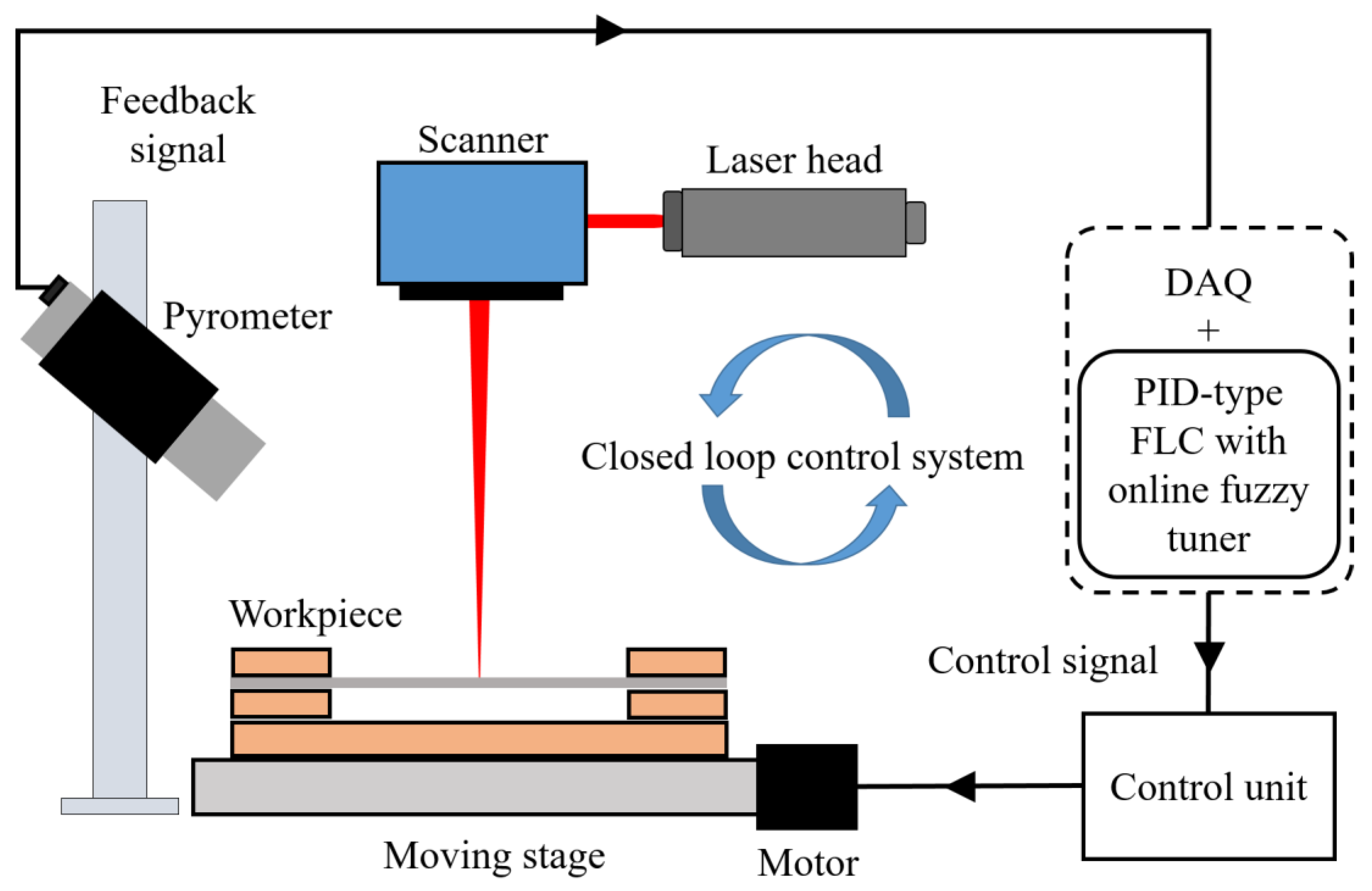



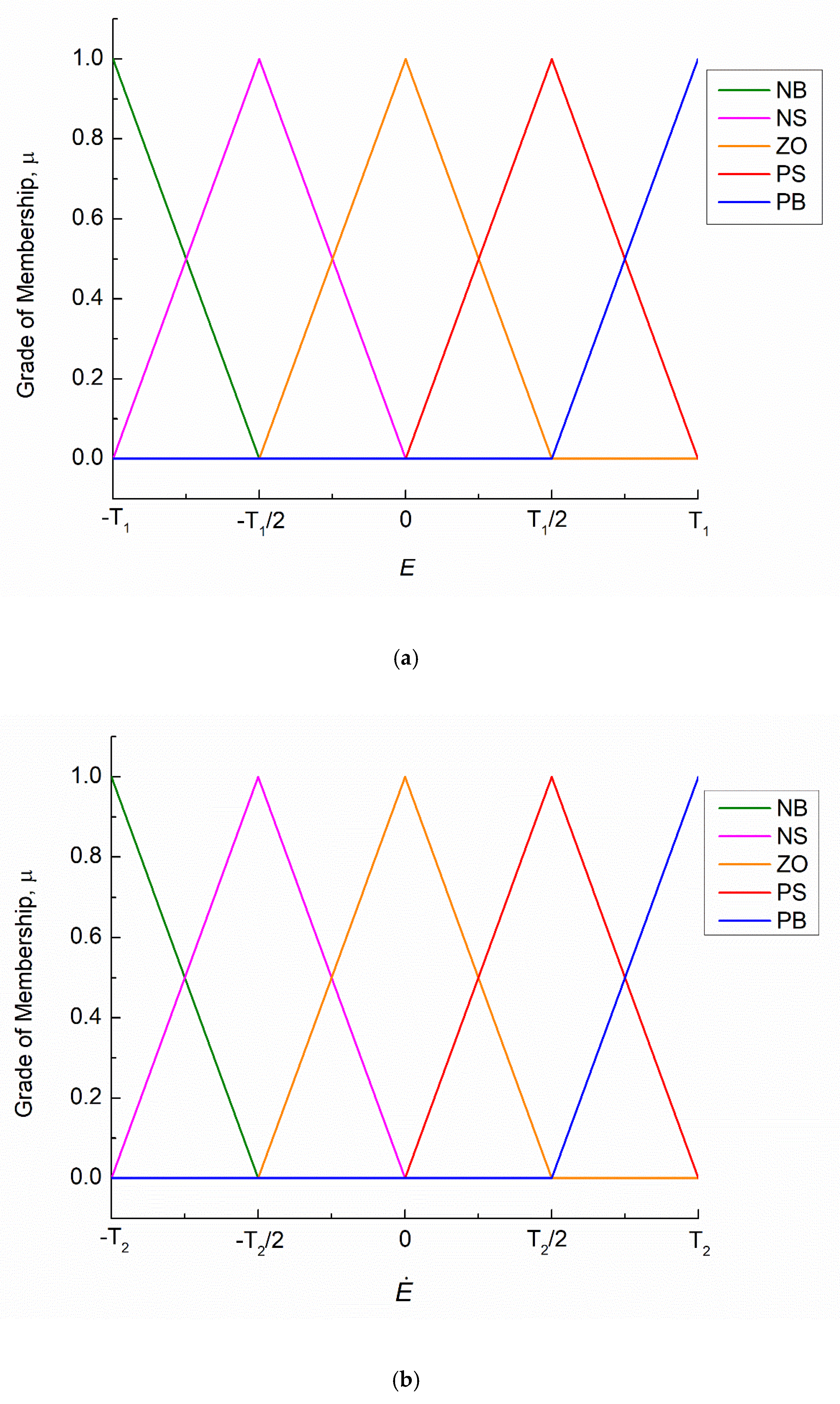


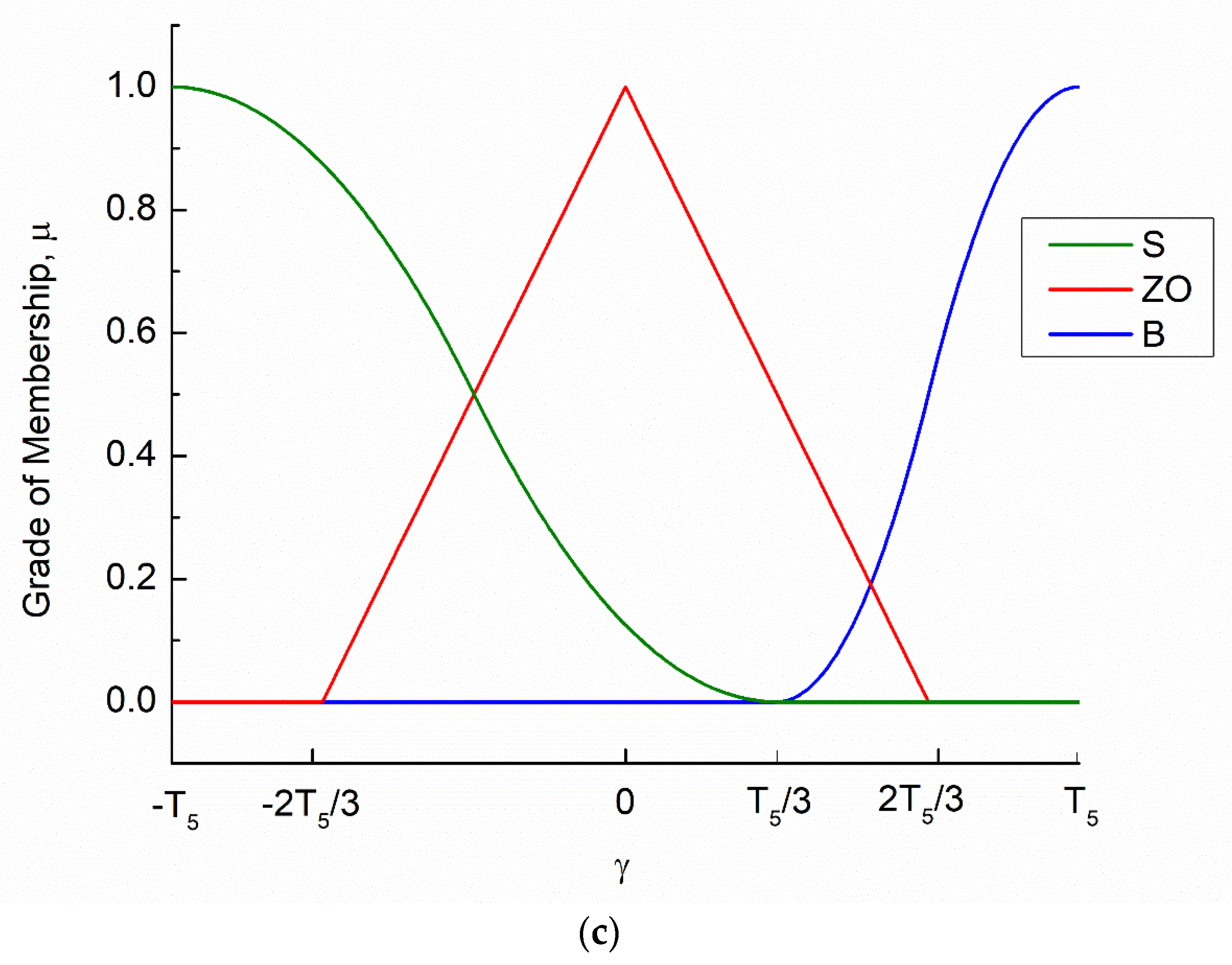

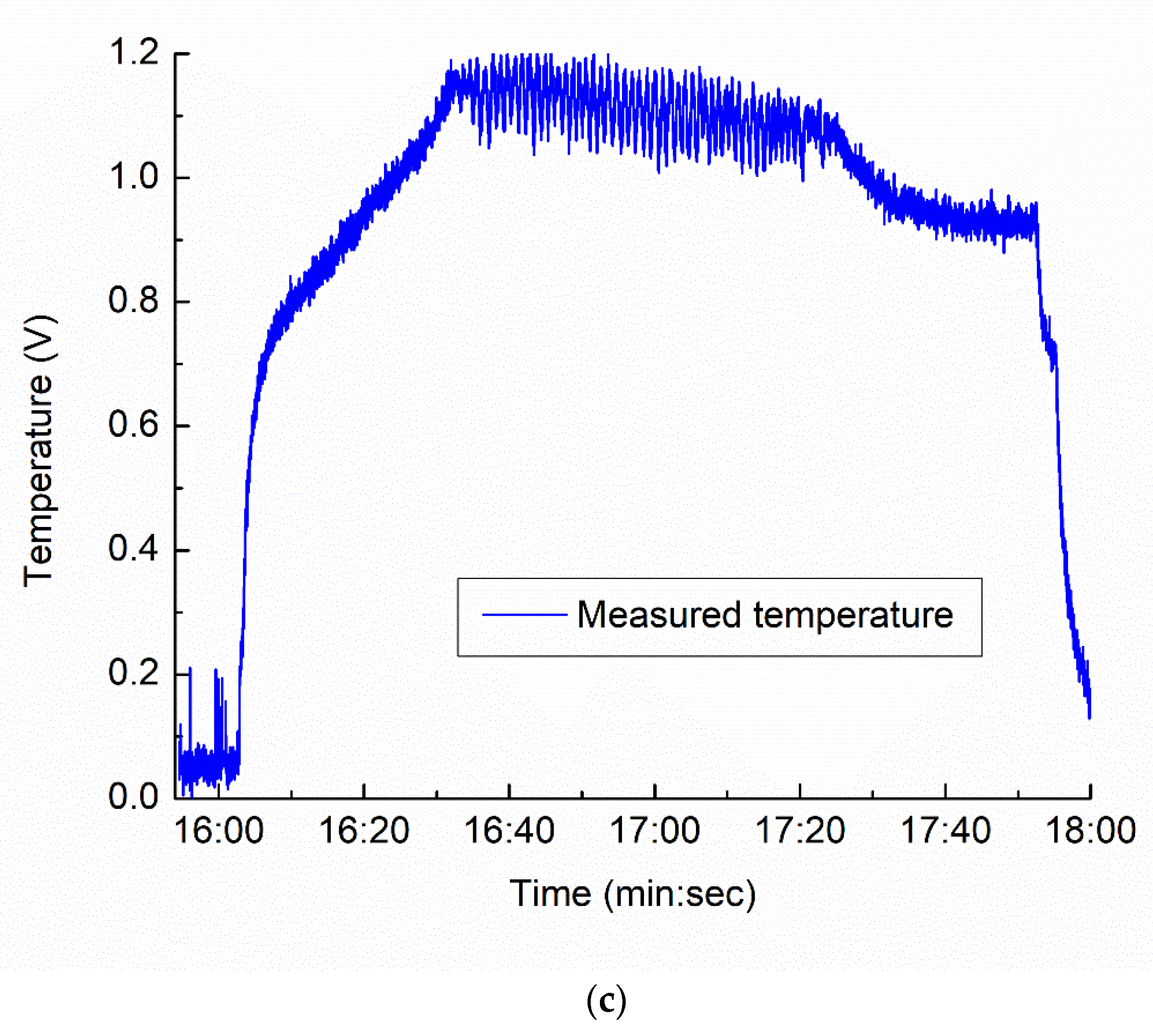
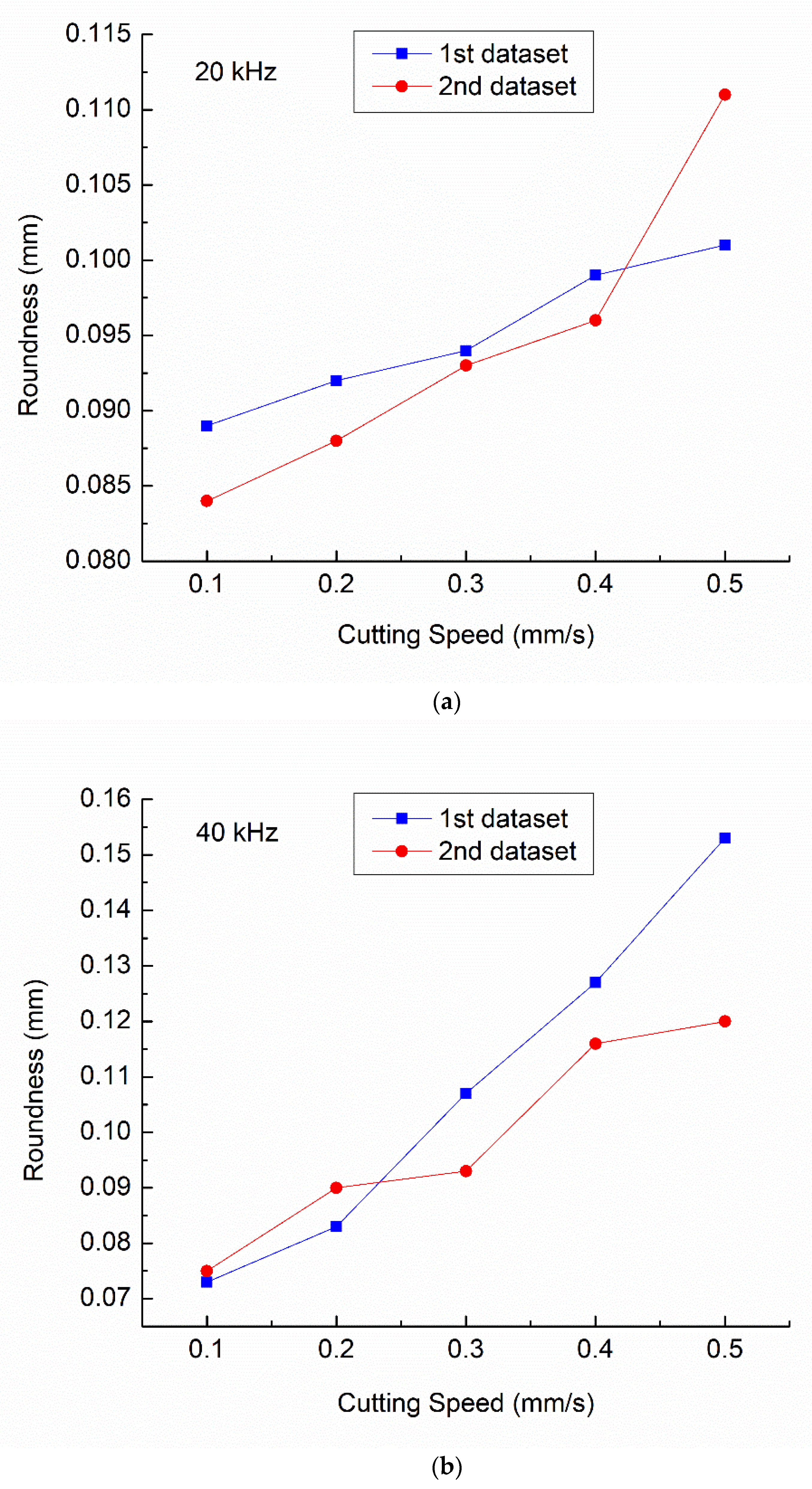
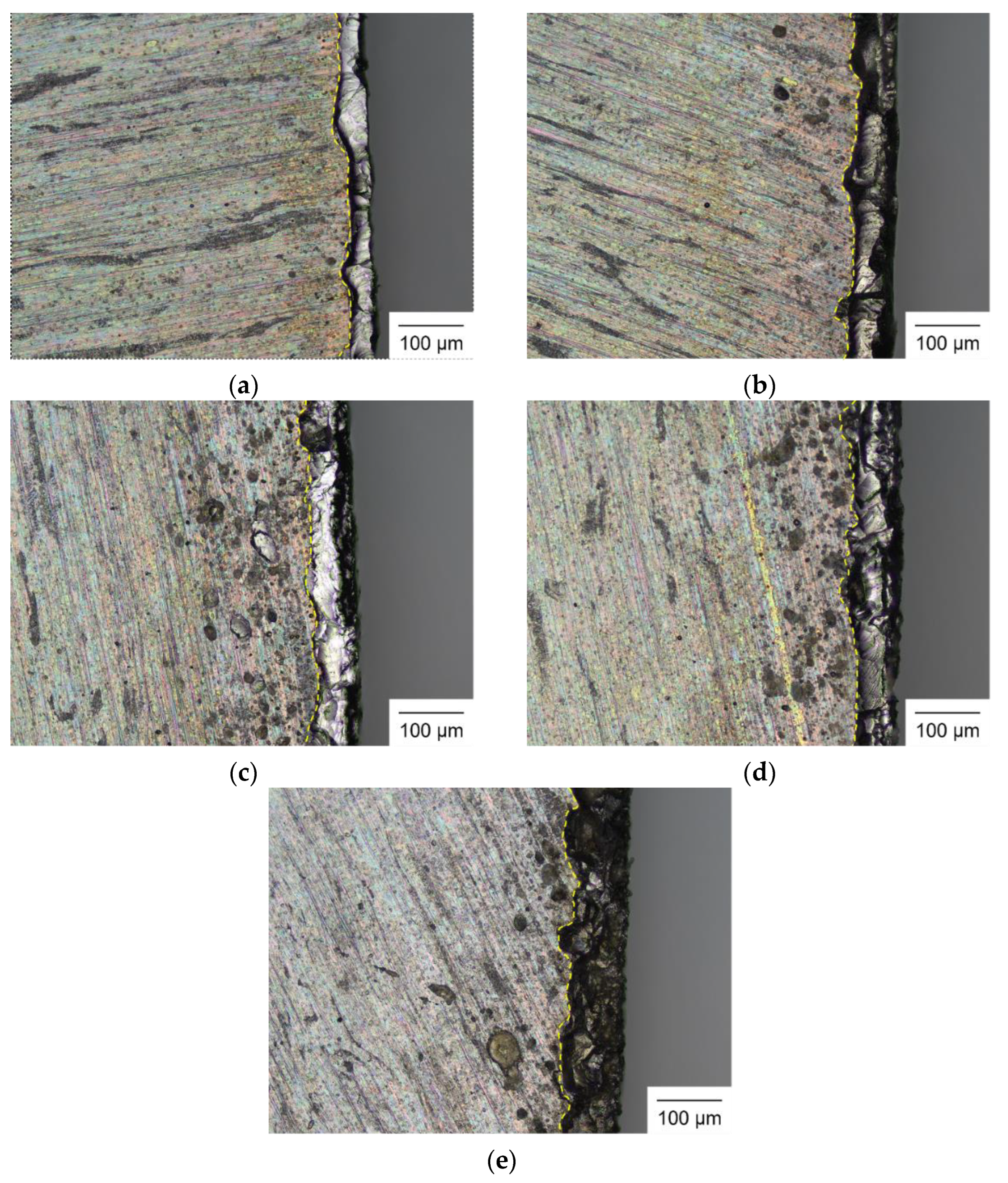

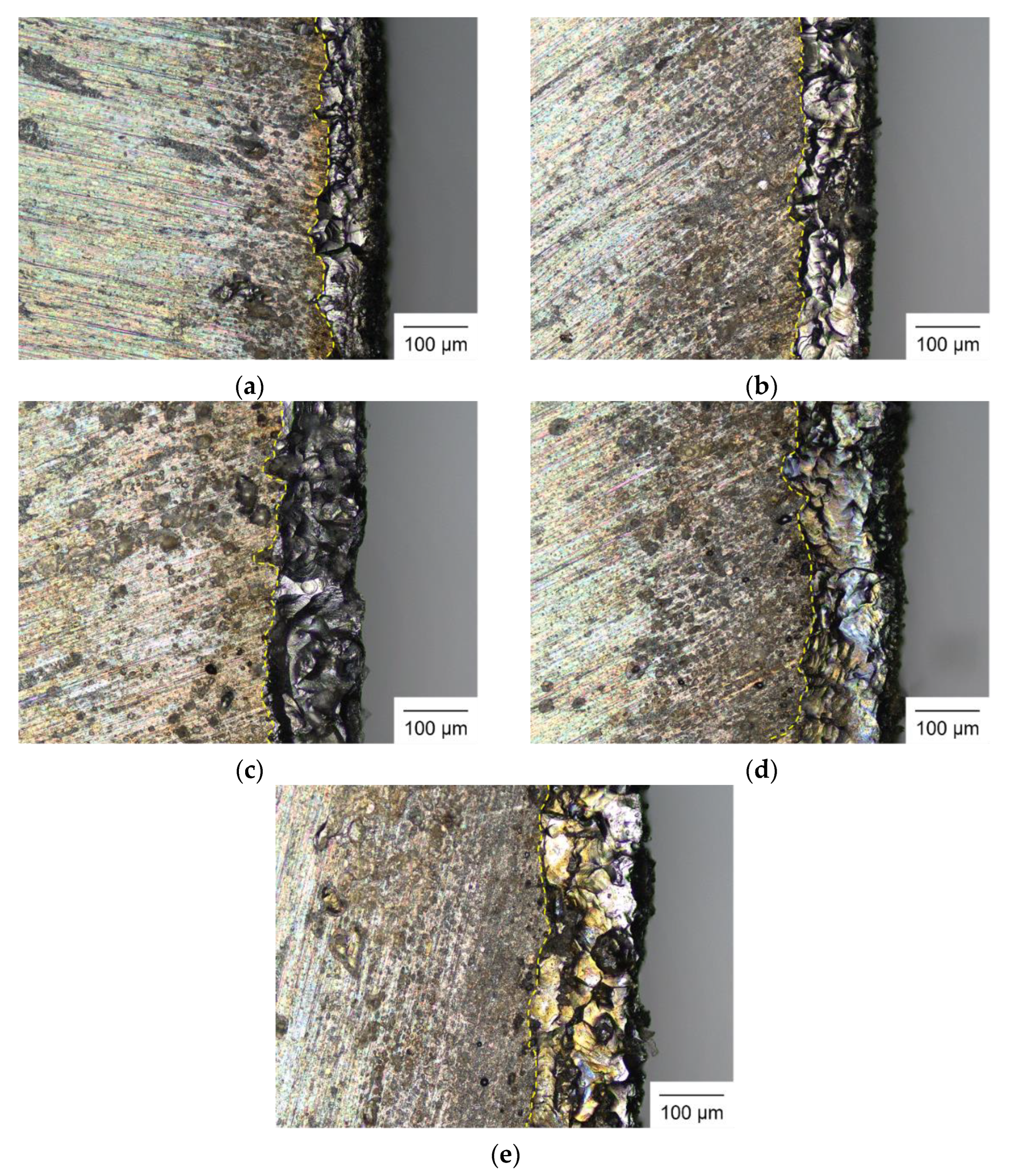
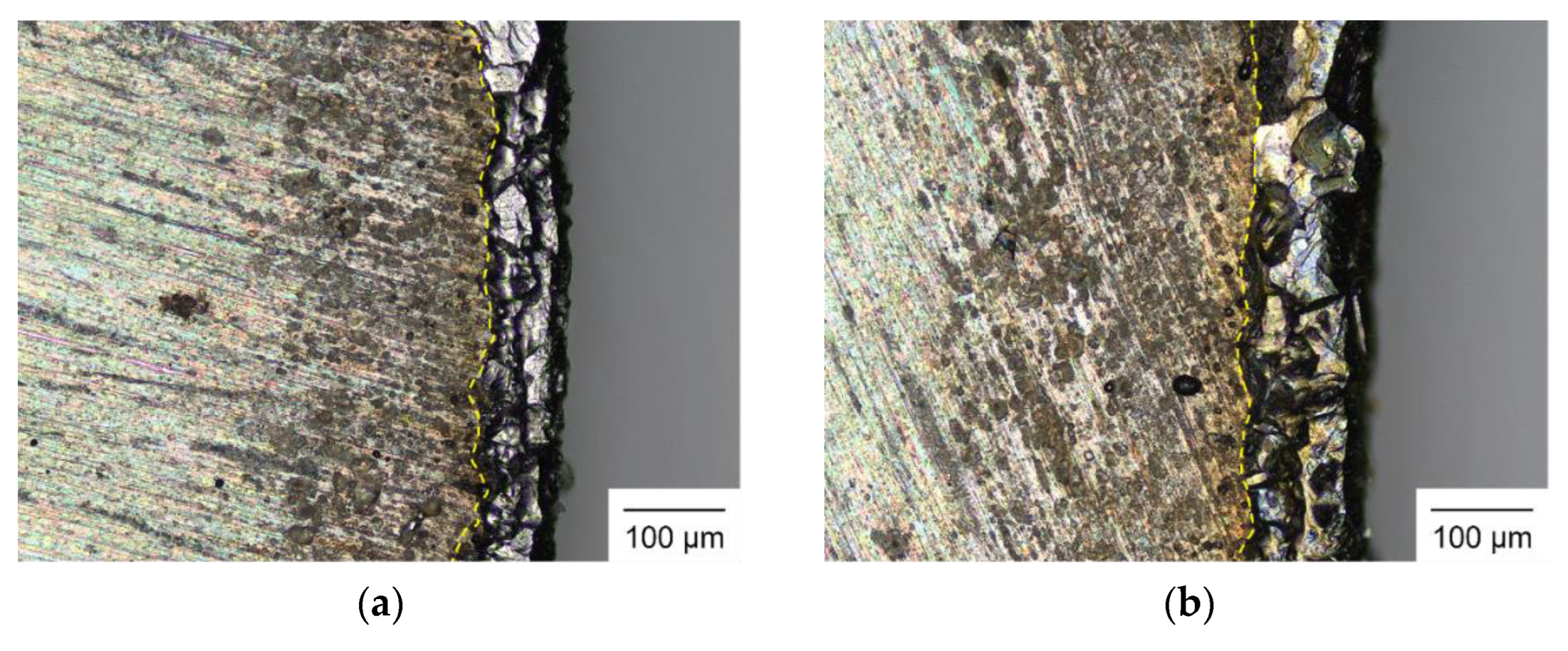
| Parameter | Open Loop | Closed Loop |
|---|---|---|
| Cutting speed (mm/s) | 0.1, 0.2, 0.3, 0.4, and 0.5 | Adjusted from 0.1 to 0.7 |
| Laser power (W) | 14.07 | 14.07 |
| Pulse width (ns) | 100 | 100 |
| Pulse frequency (kHz) | 20, 40 | 20, 40 |
| Spot diameter (μm) | 50 | 50 |
| Focal length (mm) | 330 | 330 |
| Wavelength (nm) | 1064 | 1064 |
| e | |||
|---|---|---|---|
| N | Z | P | |
| N | ZO | ZO | ZO |
| Z | B | B | B |
| P | ZO | ZO | ZO |
| Temperature Set-Point (V) | Roundness at 20 kHz (mm) | Roundness at 40 kHz (mm) | ||||
|---|---|---|---|---|---|---|
| 1st Sample | 2nd Sample | 3rd Sample | 1st Sample | 2nd Sample | 3rd Sample | |
| 0.7 | 0.052 | 0.056 | 0.061 | 0.064 | 0.057 | 0.061 |
| 0.8 | 0.070 | 0.065 | 0.070 | 0.072 | 0.076 | 0.074 |
Disclaimer/Publisher’s Note: The statements, opinions and data contained in all publications are solely those of the individual author(s) and contributor(s) and not of MDPI and/or the editor(s). MDPI and/or the editor(s) disclaim responsibility for any injury to people or property resulting from any ideas, methods, instructions or products referred to in the content. |
© 2023 by the authors. Licensee MDPI, Basel, Switzerland. This article is an open access article distributed under the terms and conditions of the Creative Commons Attribution (CC BY) license (https://creativecommons.org/licenses/by/4.0/).
Share and Cite
Nguyen, D.-T.; Lin, Y.-T.; Ho, J.-R.; Tung, P.-C.; Lin, C.-K. Temperature-Controlled Laser Cutting of an Electrical Steel Sheet Using a Novel Fuzzy Logic Controller. Mathematics 2023, 11, 4769. https://doi.org/10.3390/math11234769
Nguyen D-T, Lin Y-T, Ho J-R, Tung P-C, Lin C-K. Temperature-Controlled Laser Cutting of an Electrical Steel Sheet Using a Novel Fuzzy Logic Controller. Mathematics. 2023; 11(23):4769. https://doi.org/10.3390/math11234769
Chicago/Turabian StyleNguyen, Dinh-Tu, Yuan-Ting Lin, Jeng-Rong Ho, Pi-Cheng Tung, and Chih-Kuang Lin. 2023. "Temperature-Controlled Laser Cutting of an Electrical Steel Sheet Using a Novel Fuzzy Logic Controller" Mathematics 11, no. 23: 4769. https://doi.org/10.3390/math11234769







